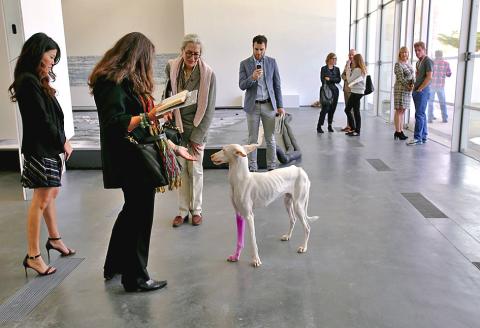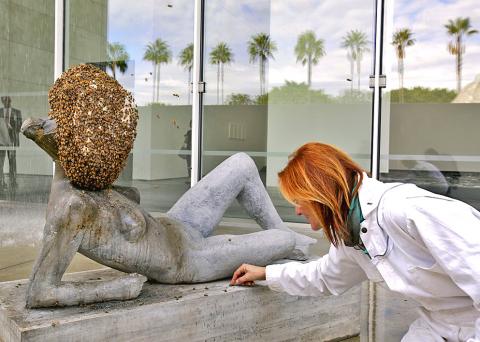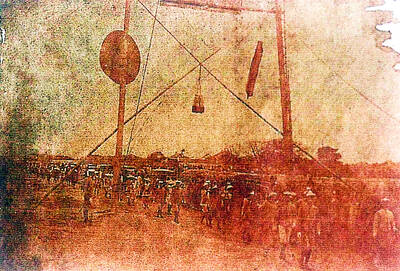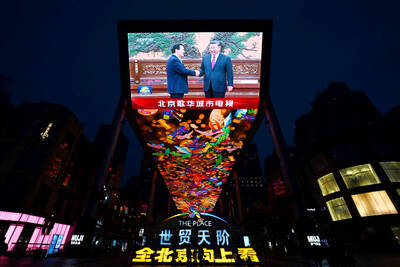Don’t worry, the white dog with the pink leg is supposed to be there, as are the bees, fake snow and rocks floating on water.
It’s all part of the unpredictable and self-described “randomness” of French contemporary artist Pierre Huyghe’s retrospective at the Los Angeles County Museum of Art (LACMA).
The show, which opens on Sunday for its only US viewing, exhibits 60 of Huyghe’s works over the past 28 years. It includes videos, interactive works, paintings as well as animals and fake weather that visitors have to confront.

Photo: Reuters
Huyghe’s art, and the show as a whole, is an open environment that’s meant to change and act randomly over time.
“I let the situation unfold; I just give the condition of a situation, but I do not know the outcome,” said the 52-year-old artist.
His works like Human, the white Ibizan Hound with the pink leg freely roaming the labyrinthine gallery of sharp diagonal walls, challenge easy definition.

Photo: Reuters
“I might not even try,” said the show’s curator Jarrett Gregory, who called Huyghe’s art an outlier in the contemporary landscape.
“It’s about the experience and not looking at discrete works,” Gregory added.
“It’s a redefinition of what we typically expect when we think of an artwork.”

Photo: Reuters
The retrospective has already been on view at the Centre Pompidou in Paris and the Museum Ludwig in Cologne, Germany. The LACMA show also features the premiere of Precambrian Explosion, an aquarium with a live ecosystem and floating rock.
Visitors are also able to step out into the California sun as machines overhead dump fake snow, fog and rain all while thousands of bees swarm from a concrete classical sculpture of a lounging nude woman with beehive head, Untilled (Liegender Frauenakt).
Huyghe says he likes to remove viewers from our human system of knowledge making them confront animal instincts.

Photo: Reuters
The 19-minute film Untitled (Human Mask), a confusion of human and animals, set against the Fukushima nuclear disaster in Japan shows a monkey in a white mask with long brown-haired wig wandering its own learned habitat: the restaurant where it works in real life.
“I’m interested in the fact that I just can’t say, do this or do that … This animal will have a survival instinct. You need to either reproduce or eat,” he said.

Photo: Reuters

Photos: Reuters

This year will go down in the history books. Taiwan faces enormous turmoil and uncertainty in the coming months. Which political parties are in a good position to handle big changes? All of the main parties are beset with challenges. Taking stock, this column examined the Taiwan People’s Party (TPP) (“Huang Kuo-chang’s choking the life out of the TPP,” May 28, page 12), the Democratic Progressive Party (DPP) (“Challenges amid choppy waters for the DPP,” June 14, page 12) and the Chinese Nationalist Party (KMT) (“KMT struggles to seize opportunities as ‘interesting times’ loom,” June 20, page 11). Times like these can

June 23 to June 29 After capturing the walled city of Hsinchu on June 22, 1895, the Japanese hoped to quickly push south and seize control of Taiwan’s entire west coast — but their advance was stalled for more than a month. Not only did local Hakka fighters continue to cause them headaches, resistance forces even attempted to retake the city three times. “We had planned to occupy Anping (Tainan) and Takao (Kaohsiung) as soon as possible, but ever since we took Hsinchu, nearby bandits proclaiming to be ‘righteous people’ (義民) have been destroying train tracks and electrical cables, and gathering in villages

Dr. Y. Tony Yang, Associate Dean of Health Policy and Population Science at George Washington University, argued last week in a piece for the Taipei Times about former president Ma Ying-jeou (馬英九) leading a student delegation to the People’s Republic of China (PRC) that, “The real question is not whether Ma’s visit helps or hurts Taiwan — it is why Taiwan lacks a sophisticated, multi-track approach to one of the most complex geopolitical relationships in the world” (“Ma’s Visit, DPP’s Blind Spot,” June 18, page 8). Yang contends that the Democratic Progressive Party (DPP) has a blind spot: “By treating any

Swooping low over the banks of a Nile River tributary, an aid flight run by retired American military officers released a stream of food-stuffed sacks over a town emptied by fighting in South Sudan, a country wracked by conflict. Last week’s air drop was the latest in a controversial development — private contracting firms led by former US intelligence officers and military veterans delivering aid to some of the world’s deadliest conflict zones, in operations organized with governments that are combatants in the conflicts. The moves are roiling the global aid community, which warns of a more militarized, politicized and profit-seeking trend